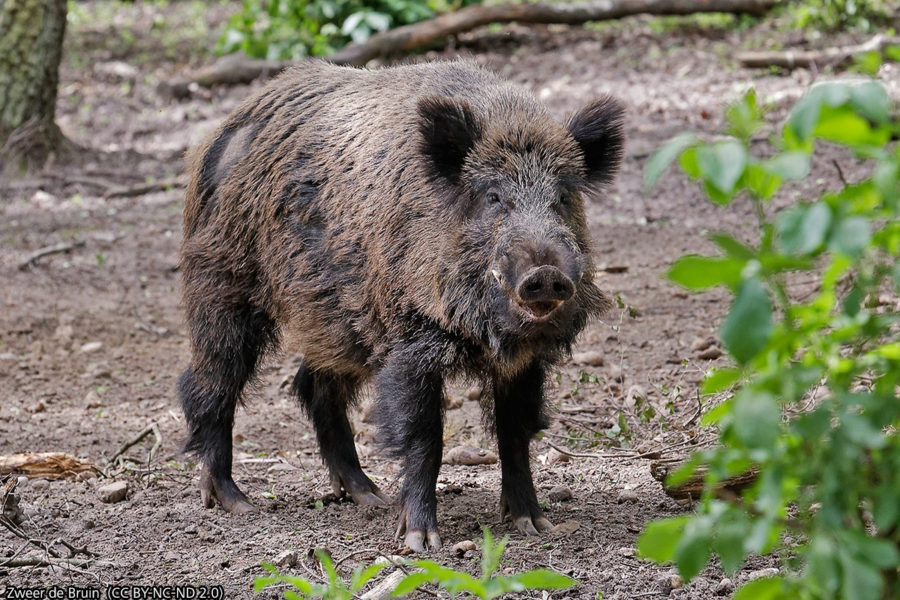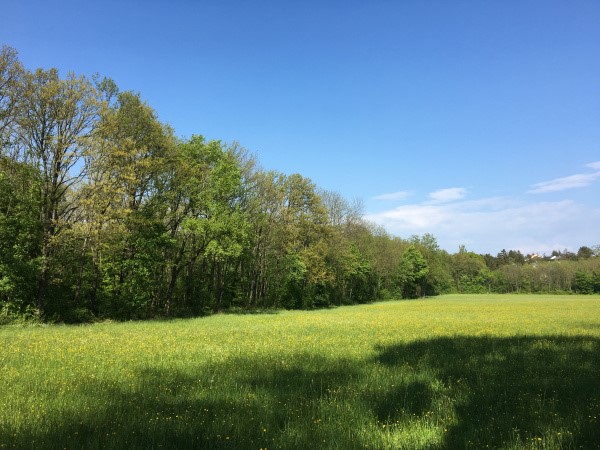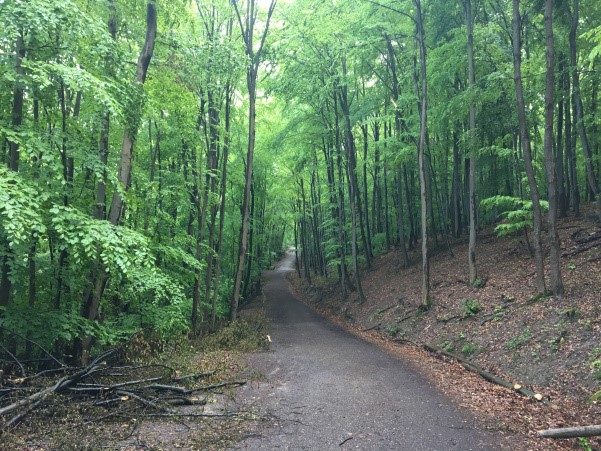15th May 2017 Vienna, Austria
An encounter with a Viennese wild boar

Climbing through the woods after a cloudburst, I follow the path around a corner to find myself confronting a group of wild boar – four or five hulking adults and countless piglets – known, charmingly, as Frischlinge in German.
I am closer to them than either they, or I, would wish.
I turn and walk slowly away, avoiding sudden movements.
Moments later I hear a noise behind me like galloping horse, and turn to see a massive wild boar, head down, charging straight at me.
Clearly, it can run faster than I can. What to do?
I have some experience of wild boar. I know that they are mostly shy, and keep out of the way of people. My approach has always been to assume that they are more frightened of me than I am of them. So how can it come about that you find yourself being charged by a wild boar? What should you do? Since my experience, I have done a bit of research to find out.
It all began as a walk in the park. I had come back from attending the commemoration events at Mauthausen concentration camp near Linz and felt like stretching my legs. So I drove to the Lainzer Tiergarten, a historic park on the edge of Vienna which features steep, wooded hills, a lookout tower, parkland and, as always in Austria, well-placed scenic cafes.
 Sunshine after the rain in the glorious Lainzer Tiergarten
Sunshine after the rain in the glorious Lainzer Tiergarten
After a spell of sunshine, the colours rendered all the more lovely by the fact that it had just stopped raining, a fresh downpour emptied the park of all but a few intrepid, well-equipped or foolhardy walkers. Walking in the rain, I was delighted to see a group of maybe 25 wild boar, both adults and infants, cross the path about 100 metres ahead and head into the forest. In nine years in Germany and nearly four in Austria I had never seen wild boar so close up.
Half an hour later, the rain had stopped. I had just passed the Rasthaus Hirschgstemm and started climbing into the woods when I almost walked into a second large group of boar, again comprising adults and juniors. A couple of the adults started, obviously disturbed by my arrival. I remembered that in this situation you were supposed to avoid alarming the animals. So I began, slowly, to walk away from the group.
It was at this point at I heard the thundering sound behind me and turned to discover I was in a dangerous situation.
Not having prior experience of boar attacks, I ran, seeking refuge. A pile of tree-trunks looked easier for me to climb than for the boar; I attempted to scale it and slipped on the wet wood, scratching and bruising myself in multiple locations as I scrambled to a place of safety.
By the time I turned round, the boar (no doubt thinking “that’s got rid of that swine”) had trotted back to join the rest of the group, which was melting back into the forest.
All my minor injuries were self-inflicted: the boar never made contact. A visit to the doctor the next morning revealed no broken bones: but she put my hand in a pity-inducing splint to stabilise it while the bruising went down.

The pity-inducing splint
So, what might I have done differently? I have googled a range of advice, most of which tells you that attacks are rare and that if you come across a group of wild boar you should take care not to alarm them. Experts point out that, notwithstanding the generally non-aggressive nature of boar, you should take special care if both adults and young are present and should on no account attempt to stroke or feed the Frischlinge.
Hard to argue with that.
I found this piece of advice, which places wild boar, alongside elephants, rhinos, crocodiles and hippos, amongst the world’s most dangerous animals (“thick, razor-sharp tusks and a razor-sharp mind”). Perhaps most useful I found this (in German) which, after telling you repeatedly that boar are unlikely to attack, says that if they do, you should climb some rocks or a tree (“you will be surprised at your climbing skills if a boar is chasing you”) and helpfully points out that boars have a nasty bite which can lead to “extreme injuries”.
I also found the British site friendsoftheboar, including the sentence: “Sadly, stories over the centuries from hunters have led to caricatures of charging boar with big tusks”. I have sympathy with these arguments: researching this blog I found a couple of grisly video compilations showing boars interacting with hunters. These left me in every case rooting for the boar.
But clearly, as my experience shows, there is a residual risk even for a peacenik hiker.
 A beautiful forest path in the Lainzer Tiergarten: no boar in sight
A beautiful forest path in the Lainzer Tiergarten: no boar in sight
So what would I do next time, based on my experience of a single boar attack?
(i) if I again came across boar unexpectedly close-up, I would, as a first action, check where I might take refuge in the improbable event that one of the boars felt threatened. I might look for a tree or other obstacle to climb or get behind;
(ii) if I were moving away from a group of boar again, I would walk backwards so I could see, in the even more improbable event that one were heading my way (NB readers have pointed out that this would increase my chances of tripping over something and injuring myself, making the choice between walking backwards and forwards a difficult one);
(iii) in the incalculably improbable event that a boar charged me again, I would try to take refuge by climbing something or getting behind or on top of something. My bruises and scratches are insignificant compared with being gored by a charging boar;
(iv) as a last resort, I might follow the advice of some websites to jump aside at the last moment. But this sounds a risky manoeuvre to me.
Will I go to the Lainzer Tiergarten again? Yes; I look forward to it, and certainly bear no grudge towards the local wildlife. But next time, I would take a flask of coffee and a bar of chocolate (both certain to enhance any walk) and, as standard equipment, a first-aid kit.
PS if you want to hear more about what a British ambassador does when not escaping wild boar, do follow me on twitter at @leighturnerFCO.
I enjoyed the story and the photos are beautiful. As I was hiking yesterday I slipped on a stone and injured my knee even without seeing a boar. At least I am not the only one with bruises! Anyway | have learnt my lesson as well, next time I am taking
hiking sticks and hiking shoes not sneakers!
Hello Mr Turner.
My hobby is running and as a matter of fact the Lainzer Tiergarten is my favourite training area. The Lainzer Tiergarten Wildschwein have never bothered me . . . so far! Last year in the Lobau Park a friend of mine out jogging suddenly heard a crashing in the undergrowth and on looking round found himself being chased by a wild boar. Being an elite runner he accelerated and managed to get clear. Lesser mortals, we must careful out there 😉
Great story… When I was in the US wild boar were all over our camp in the morning Some grow huge!!!
Glad you made it to safety though… Mr Turner
Some this wild board have some angry wild in habist with others?
Great story to read, I live in Colombia and an encounter with a wild boar is very unlikely, even though it made me feel the adrenaline rush you might experienced. Thanks for sharing!
I can sympathise with you! I had a similarly terrifying experience many years ago in exactly the same park. (In fact, when I saw the BBC headline, I knew instantly, which park you’d been in)! In my case, I inadvertently got too close to some young pigs or boars or whatever they are. Before I knew it, Mama boar came crashing through the undergrowth at high speed, sending me scurrying up a tree in fear of my life! No injuries – this tree had a ladder up it leading to the wooden hideout on top – and it’s given me many a laugh since. Not sure that the walking backwards trick would work – I wouldn’t have had the nerve.
That said, it is a lovely park. Hope you enjoy your time in Vienna.
Jennifer thanks. Good to hear I’m not the only one! Glad you also survived.
Good story. I live near the Forest of Dean, which is well known for wild boar and although I’ve seen whole families of them I’ve never known anyone be attacked other than in apocryphal stories told in pubs. However, the evidence of cross-bars on medieval hunting spears should tell us something about a large adult boar’s ability to skewer itself in sacrifice to get to the source of the perceived threat. Take care. Garstanford
Thanks for the kind words. I’ve lived around boar-inhabited forests for years in Germany and Austria and even seeing one is a rare event. I reckon the combination of heavy rain and few people lured them out.
Wow what an adrenaline surge!
Indeed. For those that actively seek an adrenalin rush, I can recommend being charged by a wild boar.
Oh my! What an experience and quiet a story to tell! Amazing!
Unforgettable, quite literally.
Thanks for the interesting story. Nature is very beautiful.
Thanks Evhen!
I forgot to mention that Austrians are usually brought up with Grimm’s fairy tales. “Das tapfere Schneiderlein” offers a different solution to what you suggested when encountering a wild boar. You might want to contemplate this slightly different but effective method, just make sure to plan your trips around chapels or the like.
:))) Dear Sir, I really enjoyed reading about your encounter with an Austrian boar. But I don’t think a flask with coffee and a chocolate bar would have improved your situation since you are not supposed to feed these animals. Surely you are not planning to hit a probable future attacker with your flask? Don’t worry, I am not being serious, I just find your experience very amusing. Having lived in Austria for 54 years now I have never put myself in a similar situation. I have seen your interview with Ms Engstler on TV and therefore became aware of your blog. I do hope your injuries will heal soon. You don’t match the British stereotype of a stiff man (in the sense of constrained not dead!), whereas you seem to live up to our expectations that the British are extremely polite. Wishing you a fabulous time in Austria without any further attacks, Pia Wimmer-Furian
Thanks Pia for your kind wishes! A flask of coffee improves any situation but on this occasion I’d have enjoyed it as I calmed down after the incident 🙂